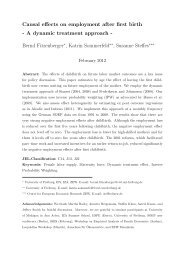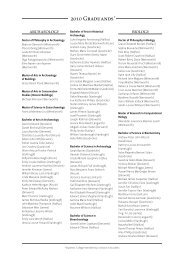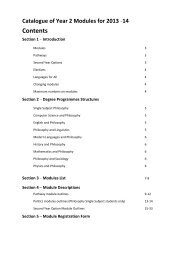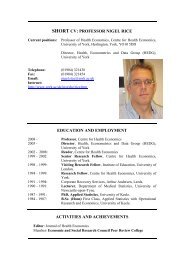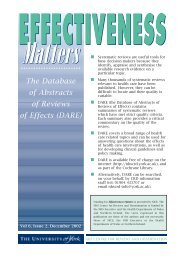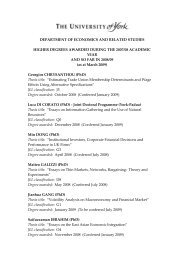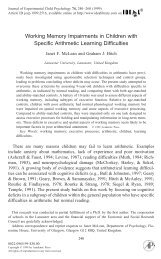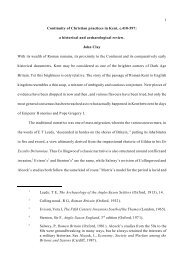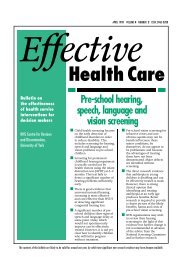GeloriniPhD (PDF , 6973kb) - University of York
GeloriniPhD (PDF , 6973kb) - University of York
GeloriniPhD (PDF , 6973kb) - University of York
You also want an ePaper? Increase the reach of your titles
YUMPU automatically turns print PDFs into web optimized ePapers that Google loves.
Introduction<br />
. 19 .<br />
INTRODUCTION<br />
“The best prophet <strong>of</strong> the future is the past” (George Byron, 1821) is a well-known existential quote, which surely applies to<br />
all research fields dealing with the past. It reminds us <strong>of</strong> history repeating itself when lessons from the past are not being<br />
considered in reflections on the present and future. Even though this idea is a truism, it still lack essential insight about<br />
the role <strong>of</strong> the present, which is as important as the past, particularly in the Earth Sciences, where the present is directly<br />
incorporated into the principle <strong>of</strong> uniformitarianism. Hence, we first need to evaluate Earth’s current natural and humaninduced<br />
processes carefully to understand the past environmental changes which underly future prospects.<br />
The recurrent idea <strong>of</strong> ‘Present and past as inseparable guides for the future’ is also strongly noticeable in the BelSPO-project<br />
‘Climatic and Anthropogenic Impact on African Ecosystems’ (CLANIMAE, 2007-2010), which forms the framework <strong>of</strong> this<br />
PhD research. CLANIMAE responds to the urgent need <strong>of</strong> a long-term perspective to today’s climate-human-ecosystem<br />
interaction in tropical Africa, in order to improve local strategies for management and biodiversity conservation. Based<br />
on observations <strong>of</strong> current lake ecosystems, and reconstructions <strong>of</strong> vegetation and water-quality changes, recorded in<br />
high-quality lake-sediment archives, CLANIMAE aims to provide better insight into present and ancient climate variability<br />
and land-use changes at the regional scale (Verschuren et al., 2009a). As part <strong>of</strong> the CLANIMAE project, this PhD research<br />
mainly focuses on developing a new palaeoenvironmental proxy for climate change and anthropogenic impact on East<br />
African ecosystems, based on analyses <strong>of</strong> non-pollen palynomorphs (NPPs) i.e. non-pollen micro-remains from vascular<br />
plants, algae, fungi, insects and other invertebrates, encountered on pollen slides. Its four chapters are dedicated to the<br />
exploration <strong>of</strong> NPPs preserved in ancient (Chapters 1 and 4) and modern (Chapters 2 and 3) lake sediments from East<br />
Africa.<br />
A brief review <strong>of</strong> historical climate-human-ecosystems interaction in East Africa<br />
Introduction<br />
Identifying the principal drivers <strong>of</strong> environmental change is highly challenging, though prerequisite for developing<br />
integrated and community-based ecosystem management and conservation strategies (e.g., IPCC, 2001, 2007; Nelleman<br />
and Corcoran, 2010). New scientific ideas about climate-human-ecosystem interaction suggest a complex theory<br />
with the related concepts <strong>of</strong> nonlinear change, feedback and regime shifts (e.g., Scheffer et al., 2001; Dent et al., 2002;<br />
Folke et al., 2004), instead <strong>of</strong> a simplified dichotomy between climatic determinism and human resource exploitation<br />
(e.g., Huntington, 1915, 1945; Manley, 1958) (Dearing, 2006). Ironically, these seemingly contradictory ideologies are<br />
also strongly related to one another, since our evolving understanding <strong>of</strong> complex ecosystem behaviour starts with<br />
determining the role <strong>of</strong> individual ecological variables, involved in the synergistic processes <strong>of</strong> environmental change.<br />
African environments, in particular, are extremely vulnerable to climate change, aggravated by the interaction <strong>of</strong><br />
multiple stresses, such as high population growth, poor infrastructure, and conflicts, resulting in low adaptive capacity<br />
(Thomas and Twyman, 2005; Boko et al., 2007). Agricultural production, food security and water-resource availibility are<br />
strongly compromised by rainfall variability (Mendelsohn et al., 2000; Conway et al., 2005; Goulden, 2005). This, in turn,<br />
interacts with human drivers, such as land-use change (e.g., deforestation, slash-and-burn practices, overexploitation<br />
<strong>of</strong> rangelands…) and the introduction <strong>of</strong> exotic species, which severely undermine the biodiversity and natural<br />
functioning <strong>of</strong> African terrestrial and aquatic ecosystems (Boko et al., 2007). Soil erosion has severely increased as a<br />
result <strong>of</strong> intensified land use (crop-rotation, over-grazing, logging), land fragmentation (loss <strong>of</strong> buffer strips) and



